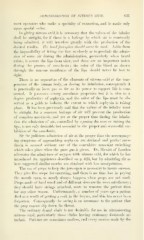Page 633 - My FlipBook
P. 633
;
ADMINISTRATION OF NITROUS OXID. 631
most operators who make a specialty of extraction, and is made only
upon special order.
In ffivino; nitrous oxid it is necessary that the valves of the inhaler
shall be airtight, for if there is a leakage by which air is constantly
being admitted, it will interfere greatly with the production of the
desired results. The hood face-piece should never be used. Aside from
the impossibility of fitting the face so closely as to preclude the admis-
sion of some air during the administration, particularly when beard
exists, it covers the lips from view, and these are an important index
during the process of anesthesia ; the color of the l)lood as shown
tiirough the mucous membrane of the lips should never be lost to
sight.
There is no separation of the elements of nitrous oxid at the tem-
perature of the human body, or during its inhalation, consequently it
is jn-actically an inert gas so far as its power to support life is con-
cerned. It possesses strong anesthetic properties but it is also to a
degree productive of asphyxia, and the color of the lips must be ob-
served as a guide to indicate the extent to which asphyxia is taking
place. It has been previously said that the valves of the inhaler must
be airtight, for a constant leakage of air will prevent the production
of complete anesthesia, and yet at the proper time during the inhala-
tion the admission of air, controlled by opening the nose or raising the
lips, is not only desirable but essential to the proper and successful ex-
hibition of the anesthetic.
By the judicious admission of air at the proper time the accompany-
ing symptoms of approaching asphyxia are obviated and perfect anes-
thesia is secured without any of the convulsive muscular twitching
which takes place when the pure gas is given. Dr. Hewitt of London
advocates the admixture of oxygen with nitrous oxid, for which he has
introduced the appliances described on p. 624, but by admitting air as
here suggested similar results are obtained with less manipulation.
The use of props to keep the jaws open is necessary to insure success.
They give free scope for operating, and there is no time lost in prying
the mouth open, as nearly always happens when props are not used.
Props made of hard wood and of different sizes are the most satisfactory
thev should have strings attached, more to reassure the patient than
for any other reason. Unfortunately, a number of years ago a patient
died as a result of getting a cork in the larynx, and this has never been
forgotten. Consequently the string is an assurance to the patient that
the prop cannot slip down the tliroat.
The ordinary dental chair is not desirable for use in administering
nitrous oxid, particularly those chairs having stationary footstools at-
tached. Patients are sometimes restless, and every motion made by the
ADMINISTRATION OF NITROUS OXID. 631
most operators who make a specialty of extraction, and is made only
upon special order.
In ffivino; nitrous oxid it is necessary that the valves of the inhaler
shall be airtight, for if there is a leakage by which air is constantly
being admitted, it will interfere greatly with the production of the
desired results. The hood face-piece should never be used. Aside from
the impossibility of fitting the face so closely as to preclude the admis-
sion of some air during the administration, particularly when beard
exists, it covers the lips from view, and these are an important index
during the process of anesthesia ; the color of the l)lood as shown
tiirough the mucous membrane of the lips should never be lost to
sight.
There is no separation of the elements of nitrous oxid at the tem-
perature of the human body, or during its inhalation, consequently it
is jn-actically an inert gas so far as its power to support life is con-
cerned. It possesses strong anesthetic properties but it is also to a
degree productive of asphyxia, and the color of the lips must be ob-
served as a guide to indicate the extent to which asphyxia is taking
place. It has been previously said that the valves of the inhaler must
be airtight, for a constant leakage of air will prevent the production
of complete anesthesia, and yet at the proper time during the inhala-
tion the admission of air, controlled by opening the nose or raising the
lips, is not only desirable but essential to the proper and successful ex-
hibition of the anesthetic.
By the judicious admission of air at the proper time the accompany-
ing symptoms of approaching asphyxia are obviated and perfect anes-
thesia is secured without any of the convulsive muscular twitching
which takes place when the pure gas is given. Dr. Hewitt of London
advocates the admixture of oxygen with nitrous oxid, for which he has
introduced the appliances described on p. 624, but by admitting air as
here suggested similar results are obtained with less manipulation.
The use of props to keep the jaws open is necessary to insure success.
They give free scope for operating, and there is no time lost in prying
the mouth open, as nearly always happens when props are not used.
Props made of hard wood and of different sizes are the most satisfactory
thev should have strings attached, more to reassure the patient than
for any other reason. Unfortunately, a number of years ago a patient
died as a result of getting a cork in the larynx, and this has never been
forgotten. Consequently the string is an assurance to the patient that
the prop cannot slip down the tliroat.
The ordinary dental chair is not desirable for use in administering
nitrous oxid, particularly those chairs having stationary footstools at-
tached. Patients are sometimes restless, and every motion made by the


